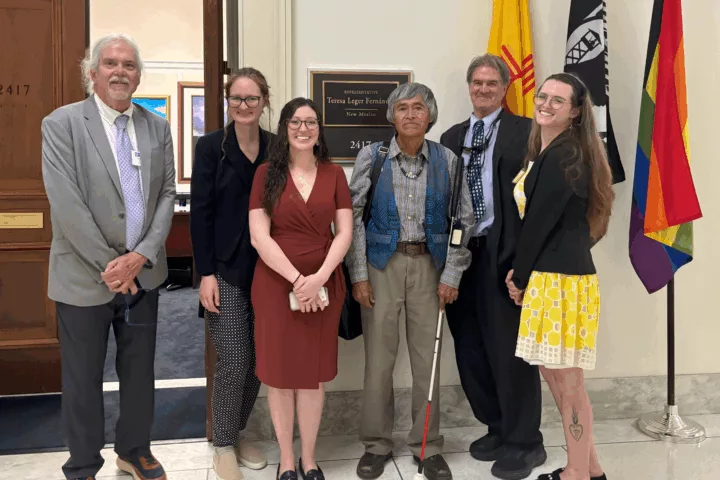Report Reveals That Little is Known About Lab’s Future Plutonium Needs
Except LANL Contractor Needs Money
A Government Accountability Office (GAO) report reveals how the future of expanded nuclear weapon component production at Los Alamos is unknown. The public has had enough of half-baked billion-dollar plans for nuclear facilities that do nothing but line contractors’ pockets. Congress must put away the check book and realize that the Lab’s plutonium future is unknown because it is unneeded.
Let’s get some details out of the way –
Los Alamos National Laboratory (LANL) houses most of the nation’s capabilities for plutonium research and development in support of the nuclear weapons mission. In addition, LANL’s scientists and technicians also perform research on plutonium to support other missions, such as conducting research on recycling plutonium for use as fuel in commercial nuclear reactors (MOX).
The National Nuclear Security Administration (NNSA), a separately organized agency within the Department of Energy (DOE), is responsible for the management of the nation’s nuclear weapons.
Plutonium pits are the fissile cores of modern nuclear weapons (fissile means capable of sustaining a nuclear reaction). When a nuclear weapon is detonated the pit is explosively compressed into a critical mass that rapidly begins atomic fission. In modern two-stage weapons the plutonium pit acts as the primary (or “trigger”) that initiates fusion in the thermonuclear secondary. Each pit is an atomic bomb in its own right, similar to the Trinity and Nagasaki bombs, both of which were plutonium bombs. In thermonuclear or hydrogen bombs the plutonium pit serves as the trigger that detonates the far more powerful fusion explosion characteristic of hydrogen bombs.
(The need for any more nuclear weapons production ever is actually zero.)
NNSA claims that the need is unknown –
Because of public participation, lack of need, and budget concerns, construction of the Lab’s $6 billion Chemistry and Metallurgy Research Replacement (CMRR) nuclear facility was deferred for at least five years starting in 2012. The CMRR would have enabled a production capacity of 50-80 pits per year. Theoretically, the Lab is currently capable of producing 10-20 pits per year, maybe. But it produced zero this year.
It is now unclear when or if the CMRR nuclear facility will be built, which the Lab claims may lead to insufficient capabilities to meet LANL’s plutonium research requirements. But no one really can say what these requirements are.
The report states the uncertainty–
The Nuclear Weapons Council is still evaluating specifications for nuclear weapons and their corresponding life extension program schedules, and it may take another year or two before final decisions are made, according to NNSA officials. Since the schedule has not been finalized, the number of pits that will be needed is uncertain as well. (Pg. 10)
Officials have announced that they are seeking alternatives to the CMRR that would provide the capabilities planned for the CMRR nuclear facility using existing facilities. This would be replacing deferred unneeded capabilities with unneeded capabilities. Instead of trying to replace the lacking capabilities of the CMRR, NNSA should first describe the actual pit needs, which are none.
Meanwhile, “NNSA has estimated that it needs to be able to ramp up its capabilities to manufacture about 30 pits each year by 2021” to meet expected life extension program requirements. (Life extension programs are intended to lengthen the lives of existing nuclear weapons by 20 to 30 years by repairing or replacing nuclear weapons components as needed.)
But the 30 number is just a guess “for planning purposes”.
For planning purposes, NNSA is studying the possibility of manufacturing about 30 pits per year… (Pg.10)
“Studying the possibility” is not a need.
NNSA now believes that LANL can support the manufacture of 30 pits per year just by upgrading its radiological laboratory and by repurposing available space in its existing plutonium facility. (Pg. 12)
Also,
Costs are unknown –
The cost estimates were characterized as “high-level and a rough order of magnitude and noted that the estimates should be viewed as preliminary and preconceptual that would not be useful for program definition or scoping.” (pg.15)
Staffing is unknown.
NNSA and LANL officials told us that recruiting additional staff for plutonium-related research necessarily takes years of advance planning, but that the uncertainty of where the new capabilities will be located or what the level of capacity is needed has complicated planning efforts. (Pg. 17)
What is know is the public is a problem –
Plans for transporting plutonium or other radioactive materials from LANL to facilities at other sites could also spur public opposition that may cause schedule delays or create other impediments…
Other impediments?
Like speaking up?

